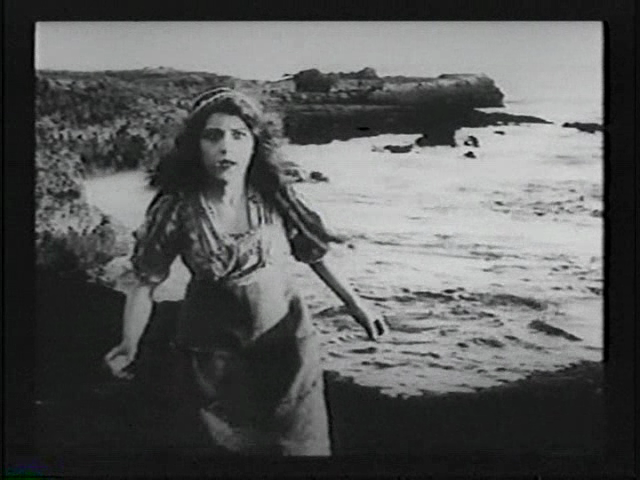The science fiction writer Bob Shaw came up with a concept called “slow glass”: a dense material through which light would take so long to pass that past events could be viewed as live many years later. Leaving aside the physics – which, frankly, I must – this is not unlike the experience of watching silent film, only the light stops as it hits the celluloid only to be unleashed at a later point, after development, by fresh energy from the projector.
The end result is almost the same, as you watch the real
lives of actors and directors unfold as they perform their photo-plays and, when
the print is a well-preserved as this one, there’s an eerie sense of human
connectivity.
Danish cinema in the pre-war years was amongst the most
technically-proficient in terms of cinematography, narrative approach and
design. They also had some marvellous performers who already grasped the
fundamentals of understated naturalism required to act convincingly well on the
big screen.
I’ve already raved many times about the supernatural Asta
Nielsen and in this film there is Valdemar Psilander, a male star who –
domestically at least – rivalled her in popularity. Psilander has an easy charm
and whilst he’s not quite the intensity of his compatriot still catches the eye
in August Blom’s morality tale.
 |
| Valdemar Psilander |
He plays Aage Hellertz a young man wasting his time and money
on a lifestyle he can’t afford. As the film opens his widowed mother (Augusta
Blad) is trying to rein him in after learning of his latest debt but, after
taking his telling off, he can’t help but wonder how his colourful friends are
getting on. Blom shows us a double exposure of his vaudeville singer friend
Stella (Thora Meincke) with his friends as Aage gives in to temptation and
arranges to see them.
A long night follows as the boys watch Stella perform from a
private box – another clever composition from Blom – and then head off for a
long and expensive supper. Aage’s money runs out and his friends desert him,
leaving him to square the bill. Luckily form him, the waiter (Holger Hofmann)
is an enterprising soul – a hospitality worker yes but also a self-styled
capitalist. He arranges to loan Aage the money at favourable terms.
Aage visits his offices the next day to arrange the deal and
is immediately taken with the waiter’s daughter Anna (Clara Pontoppidan, here
as Clara Wieth) who he impetuously kisses. The two arrange to meet and she
comes to his apartment for dinner. A good time is had by all until Mother
arrives back and, appalled at this impropriety, sends them both from her house.
 |
| Clara Pontoppidan and Valdemar Psilander |
Aage sets up house with Anna – presumably they marry? – and
falls back into his habit of spending what he hasn’t got, buying her splendid
hats and jewells. His old friends come visiting and there’s a face-off between
Stella and the young interloper Anna who proceeds to burn up the living room
floor with some elegant dancing… not just a waiter’s daughter it seems but
classically-trained?
Stella’s nose duly out of joint she departs with the rest
of the old crew. But it won’t be so easy for Aage to escape the debts of the
past and as due date approaches for the bill he becomes increasingly desperate
considering suicide before deciding to forge his mother’s signature on a
promisory note.
 |
| Anna struts her stuff, Stella gets miffed... |
But even this only buys him a little more time and as the
moment nears when the note must be presented to the bank, Aage, prompted by Anna,
goes to see his mother… Shocked and disappointed yet again in her son she
refuses to help forcing him into the desparate act of trying to steal from her…
Spoilers… Aage’s
attempted robbery is one of the visual highlights of the film as he is tracked
up the stairs by the janitor who then alerts a policeman. But as Aage is about
to take the money from his mother’s sitting room, her image appears in the
corner mirror and you know the game is quickly up - such inventive use of the
space by Blom and great work from cinematographer Axel Graatkjær.
Will Mother forgive Aage and how will he square his debt
with Anna’s father... all collide in the finale which I won’t reveal.
Temptations of a Great
City is a fine example of the high-level Danish technique of the time
albeit a relatively slight story. It is still an involving experience and this
is down to the performers… Psilander acts well as the young man detached from
his own responsibilities and, to an extent, that’s how he seems with his
emoting.
 |
| Clara Pontoppidan |
Clara Pontoppidan gives a compelling portrayal with her Anna
a woman of determination and invention (and quite some moves on the dance
floor). She went on to feature in Carl Dreyer’s Leaves from the Book of Satan
as well as Benjamin Christansen’s Haxan.
I watched the Danish Film Institute’s Psilander set which
comes with two other films which further showcase the actor’s range. There’s
also a very effective accompaniment from Mr Neil Brand which underpins the
story well with some lovely romantic lines.
It’s available direct from the DFI and also via the BFI – shop or online - plus the usual but it's cheaper from the German Edition FilmMuseum.
Don’t miss out on a crystal clear window into the pre-war world of expert
Danish film making!






.jpg)
.jpg)
.jpg)
.jpg)
+lift.jpg)
.jpg)
.jpg)
+greed.jpg)
.jpg)
.jpg)
.jpg)
+board.jpg)
+admiring.jpg)
.gif)







.png)
.png)










+Jesus+on+the+Appian+Way.png)
+smootch+2.png)
+cherries.png)


+behave+2.png)
+tailors.png)
+dance+4.png)
+suit.png)
+smoke.png)
.png)

%20Despair.png)








